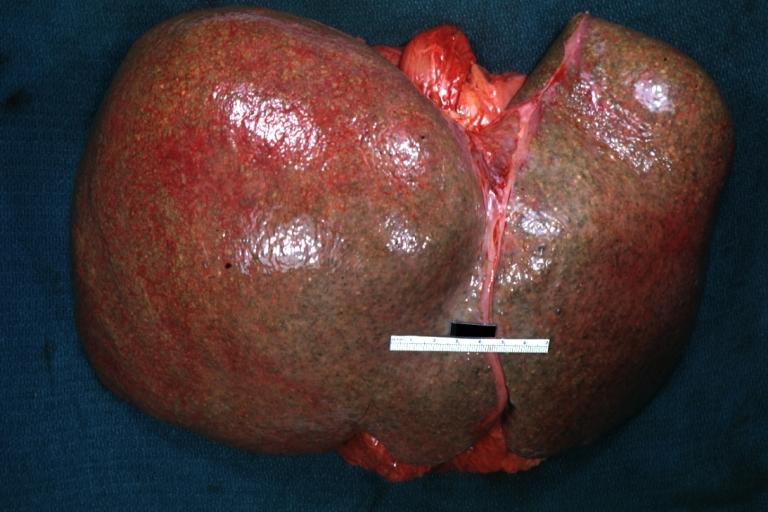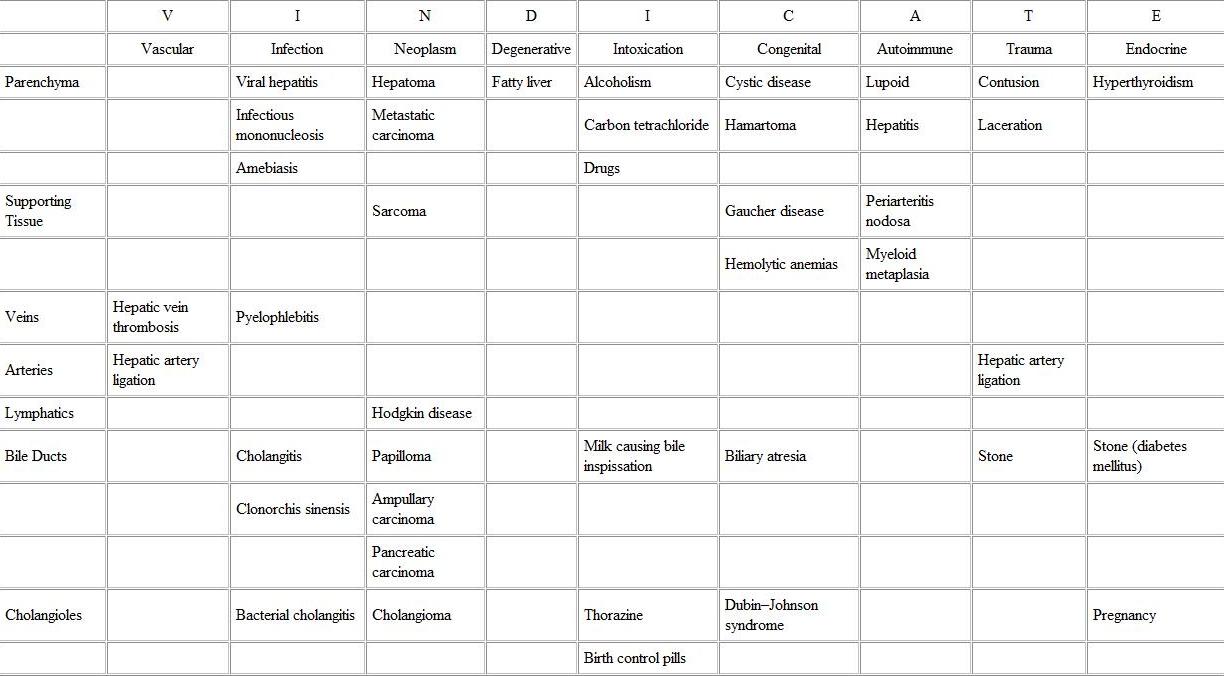Hepatomegaly
| Hepatomegaly | |
 | |
|---|---|
| ICD-10 | R16..0 |
| ICD-9 | 789.1 |
|
Hepatomegaly Microchapters |
Editor-In-Chief: C. Michael Gibson, M.S., M.D. [1]; Associate Editor-In-Chief: Cafer Zorkun, M.D., Ph.D. [2]
Synonyms and keywords: Enlarged liver, Liver enlargement
Overview
Hepatomegaly is the condition of having an enlarged liver. It is a nonspecific medical sign having many causes, which can broadly be broken down into infection, direct toxicity, hepatic tumors, or metabolic disorder. Often, hepatomegaly will present as an abdominal mass. Depending on the cause, it may sometimes present along with jaundice.
Palpable Liver without Hepatic Pathology
- Normal variant
- Thin or flaccid abdominal wall
- Depressed right diaphragm (e.g., emphysema)
- Subdiaphragmatic lesion (e.g., abscess)
- Riedel's lobe
True Hepatic Enlargement
Inflammatory liver disease
- Infectious
- Bacterial
- Glandular fever (Infectious mononucleosis) This is caused by the Epstein-Barr Virus (EBV).
- Malaria
- Hydatid cyst
- Leptospirosis
- Actinomycosis
- Viral
- Schistosomiasis
- Others
- Bacterial
- Alcoholic hepatitis
- Other toxins induced hepatitis
- Drug-induced hepatitis
- Autoimmune hepatitis
- Steatohepatitis
- Steatosis
- Others
- Infectious
- Abscess
- Pyogenic
- Amebic
- Suppurative
- Sclerosing
- Pericholangitis (especially related to ulcerative colitis)
Chronic liver disease and cirrhosis
- Alcoholic
- Posthepatitic
- Postnecrotic
- Cholestatic
Cirrhotic
- Portal
- Biliary
- Cardiac
Metabolic disorders
Alpha-1 antitrypsin deficiency
Other causes
- Extrahepatic biliary obstruction
- Choledocholithiasis
- Biliary stricture
- Pancreatitis
- Carcinoma
- Bile ducts (cholangiocarcinoma)
- Head of pancreas
- Ampulla of Vater
- External compression
- Hepatic congestion
- Congestive heart failure
- Constrictive pericarditis
- Budd-Chiari syndrome (hepatic outflow obstruction, hepatic vein obstruction)
- Thrombosis
- Tumor
- Web (inferior vena cava)
- Veno-occlusive disease
- Jamaican herbal tea
- After bone-marrow transplantation
- Infiltrative disorders, storage diseases
- Lipid accumulation
- Fatty liver
- Alcohol
- Diabetes mellitus
- Obesity
- Severe protein malnutrition (Kwashiorkor: dietary protein deficiency)
- Nonalcoholic steatohepatitis
- Jejunoileal bypass
- Parenteral hyperalimentation
- Corticosteroids, Cushing's syndrome
- Fatty liver of pregnancy
- Massive tetracycline therapy
- Toxins (e.g., carbon tetrachloride, dichlorodiphenyl trichloroethane)
- Reye's syndrome
- Lipid storage disease (especially Gaucher's disease, Niemann-Pick disease)
- Fatty liver
- Glycogen accumulation
- Glycogen storage disease
- Diabetic glycogenosis
- Granulomatous infiltration (especially sarcoidosis, miliary tuberculosis, disseminated fungal diseases, some drug reactions)
- Myeloproliferative and lymphoproliferative disorders
- Amyloidosis
- Congenital hepatic fibrosis
- Hemochromatosis
- Wilson's disease
- Lipid accumulation
- Neoplasms
- Primary
- Metastatic
- Cysts
- Congenital
- Solitary
- Polycystic
- Acquired (especially echinococcal)
- Congenital
- Hunter syndrome
- Zellweger's syndrome
- Carnitine palmitoyltransferase I deficiency
- Carnitine palmitoyltransferase II deficiency
- Carnitine-acylcarnitine translocase deficiency
Diagnosis
After a thorough medical history and physical examination, blood tests should be drawn. An important series of blood tests are the liver function tests, which give a good impression of the patient's broad metabolic picture.
An ultrasound of the liver can reliably detect a dilated biliary duct system, which helps distinguish parenchymal liver disease from extrahepatic bile duct obstruction. Ultrasound can also detect the characteristic texture of a cirrhotic liver, and can guide fine needle aspiration of cysts, abscesses and tumors.
Computed tomography (CT) can help obtain more accurate anatomical information, and is unaffected by the obesity or the presence of bowel gases.
Mnemonics for Hepatomegaly
V I N D I C A T E

See also
External links
- National Institute of Health's Medline Plus Medical Encyclopedia: Hepatomegaly
- Merck Manual: Hepatomegaly
- Goldminer: Hepatomegaly
Template:Skin and subcutaneous tissue symptoms and signs Template:Nervous and musculoskeletal system symptoms and signs Template:Urinary system symptoms and signs Template:Cognition, perception, emotional state and behaviour symptoms and signs Template:Speech and voice symptoms and signs Template:General symptoms and signs
de:Hepatomegalie fi:Hepatomegalia